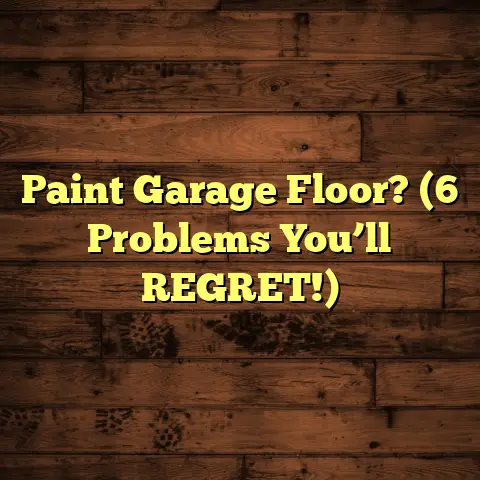Level Floor Before Epoxy? (1 Bubble Disaster!)
Have you ever dreamed of a sleek, glossy epoxy floor that transforms your space?
It’s a fantastic choice!
But, let me tell you, the difference between a showstopper and a total flop often comes down to one simple thing: leveling your floor before you even think about pouring that epoxy.
Trust me, I’ve seen it all.
I’m talking about bubbling, peeling, and a whole lot of wasted money.
Imagine this: you’ve spent hours prepping, carefully mixing your epoxy, and meticulously pouring it onto your floor, only to discover days later that it’s riddled with unsightly bubbles and uneven patches.
Nightmare fuel, right?
That’s why I’m here to tell you that skipping the leveling step is like playing Russian roulette with your flooring project.
In this article, I’m going to walk you through everything you need to know about leveling your floor for epoxy.
We’ll talk about why it’s so important, how to do it right, and what can happen if you don’t.
So, grab a coffee, settle in, and let’s make sure your epoxy floor dreams become a reality, not a bubble-filled disaster.
Section 1: Understanding Epoxy Coating
What is Epoxy?
Okay, let’s start with the basics.
What exactly is epoxy?
Epoxy is a thermosetting polymer that, when mixed with a hardener, undergoes a chemical reaction to create a durable, rigid material.
Think of it as a super-strong glue that hardens into a protective shell.
It’s made up of resins and hardeners. When these two components mix, they create a chemical reaction that transforms the liquid into a solid.
This solid is incredibly resistant to chemicals, heat, and wear, making it ideal for flooring applications.
You’ll find epoxy in all sorts of places, from residential garages and kitchens to commercial warehouses and hospitals.
It’s a versatile material that can be customized with colors, flakes, and other decorative elements to achieve a wide range of aesthetic effects.
Why Choose Epoxy for Flooring?
So, why choose epoxy for your floors?
Well, the benefits are pretty impressive.
First off, epoxy floors are incredibly durable.
They can withstand heavy foot traffic, impacts, and chemical spills without showing signs of wear and tear.
I’ve seen epoxy floors in busy auto shops that still look great after years of abuse.
Aesthetically, epoxy is a game-changer.
You can create a seamless, glossy surface in virtually any color or design.
Metallic epoxy floors, for example, can give your space a high-end, modern look that’s sure to impress.
Maintenance is another huge plus.
Epoxy floors are easy to clean and require minimal upkeep.
A simple mop and bucket are usually all you need to keep them looking their best.
Plus, they’re resistant to stains and bacteria, making them a hygienic choice for kitchens and bathrooms.
I remember working on a project for a local brewery.
They needed a flooring solution that could withstand constant spills and heavy foot traffic.
Epoxy was the perfect choice.
We installed a custom epoxy floor with their logo embedded in the design.
It not only looked fantastic but also provided a durable and easy-to-clean surface that met all their needs.
Section 2: The Importance of a Level Floor
Why Leveling Matters
Alright, let’s get down to the nitty-gritty.
Why is leveling your floor so important before applying epoxy?
Well, it all comes down to physics and adhesion.
Epoxy is a self-leveling material to a certain extent, but it relies on gravity to spread evenly.
If your floor isn’t level, the epoxy will naturally flow to the lowest points, creating thick spots and thin spots.
This uneven distribution can lead to a host of problems.
Think of it like this: imagine trying to spread butter on a piece of toast that’s full of bumps and holes.
The butter will pool in the low spots and barely cover the high spots, resulting in an uneven and messy surface.
The same thing happens with epoxy.
A level floor ensures that the epoxy spreads evenly, creating a consistent thickness and a smooth, flawless finish.
This even distribution is crucial for proper adhesion.
When epoxy is applied to an uneven surface, it can create stress points that weaken the bond between the epoxy and the substrate.
Over time, these stress points can lead to cracking, peeling, and other forms of damage.
Common Issues Caused by Uneven Floors
So, what are the specific problems you can expect if you skip the leveling step?
Bubbling is one of the most common issues.
When epoxy is applied to an uneven surface, air can become trapped underneath the coating, creating unsightly bubbles.
These bubbles not only ruin the aesthetics of your floor but also weaken the integrity of the epoxy.
Peeling is another major concern.
If the epoxy isn’t properly bonded to the substrate due to an uneven surface, it can start to peel away over time.
This is especially common in areas with high foot traffic or exposure to moisture.
Cracking is also a risk.
As I mentioned earlier, uneven floors can create stress points in the epoxy.
These stress points can lead to cracks, which can spread and worsen over time.
These issues aren’t just cosmetic.
They can significantly reduce the lifespan of your epoxy floor and require costly repairs.
According to the National Association of Floor Covering Technicians (NAFCT), uneven subfloors are a leading cause of flooring failures.
I’ve personally seen countless epoxy floors fail due to inadequate leveling.
It’s a heartbreaking situation because it’s completely avoidable with proper preparation.
Real-Life Examples of Bubble Disasters
Let me share a couple of real-life examples to drive home the point.
I once worked on a project for a homeowner who decided to save money by skipping the leveling step.
They applied epoxy to their garage floor without properly addressing the uneven surface.
Within a few months, the floor was riddled with bubbles and cracks.
The homeowner had to pay me to remove the entire epoxy coating and start from scratch.
In the end, they spent more money than they would have if they had simply leveled the floor in the first place.
Another time, I was called in to assess a commercial warehouse floor that had been recently coated with epoxy.
The floor was visibly uneven, with noticeable dips and slopes.
As a result, the epoxy had pooled in certain areas, creating thick, uneven patches.
The company had to shut down operations for several days while I repaired the floor.
These are just two examples of the many disasters I’ve witnessed due to unlevel floors.
The moral of the story is simple: leveling your floor is not an optional step.
It’s a crucial part of the epoxy application process that can save you time, money, and a whole lot of frustration.
Section 3: Assessing Your Floor’s Levelness
Tools and Techniques for Measurement
Okay, so how do you actually determine if your floor is level?
Fortunately, there are several tools and techniques you can use.
A laser level is one of the most accurate and efficient tools for assessing floor levelness.
These devices project a laser beam across the room, creating a perfectly level reference line.
You can then use a measuring tape to measure the distance between the laser line and the floor at various points.
Any variations in distance indicate unevenness.
A straight edge is a simpler, more affordable option.
These are typically long, rigid metal or wood bars that you can place on the floor to check for gaps or slopes.
A good straight edge should be at least 6 feet long for accurate results.
A spirit level (also known as a bubble level) is another essential tool.
These devices use a bubble in a liquid-filled tube to indicate whether a surface is level or plumb.
You can place a spirit level on the floor and check the position of the bubble to determine if the floor is level.
A digital level is a more advanced version of a spirit level that provides a digital readout of the angle of inclination.
This can be helpful for precisely measuring the slope of your floor.
Here’s a step-by-step guide on how to assess your floor’s levelness:
- Clean the floor: Remove any debris, dust, or dirt that could interfere with your measurements.
- Set up your laser level: Place the laser level in the center of the room and turn it on.
- Mark your reference points: Use a marker to mark the laser line on the walls at several points around the room.
- Measure the distance: Use a measuring tape to measure the distance between the laser line and the floor at various points.
- Record your measurements: Write down your measurements in a notebook or spreadsheet.
- Analyze the data: Compare your measurements to identify areas where the floor is uneven.
Identifying Problem Areas
Now that you know how to measure your floor’s levelness, let’s talk about how to identify problem areas.
Common signs of an unlevel floor include:
- Visible gaps: Gaps between the floor and the baseboards or walls can indicate an uneven floor.
- Slopes: If you can visually detect a slope in the floor, it’s definitely not level.
- Dips and humps: These are obvious signs of an uneven floor.
- Water pooling: If water tends to pool in certain areas of the floor, it’s likely that those areas are lower than the surrounding surfaces.
When documenting problem areas, be as specific as possible.
Note the location, size, and severity of each issue.
Take photos or videos to document the condition of the floor.
Prioritize areas that need leveling based on their severity and location.
Areas with large dips or humps should be addressed first.
Areas that are located in high-traffic areas should also be prioritized.
Section 4: Preparing to Level Your Floor
Gathering Necessary Materials and Tools
Alright, you’ve assessed your floor and identified the problem areas.
Now it’s time to gather the materials and tools you’ll need to level it.
Here’s a list of essential items:
- Self-leveling compound: This is a cement-based mixture that you pour onto the floor to create a level surface.
- Mixing bucket: You’ll need a large bucket to mix the self-leveling compound.
- Drill with mixing paddle: A drill with a mixing paddle will help you thoroughly mix the compound.
- Spiked roller: A spiked roller helps release air bubbles from the self-leveling compound.
- Smoothing tool: A smoothing tool helps you spread the compound evenly.
- Leveling rake: A leveling rake helps you control the thickness of the compound.
- Floor scraper: A floor scraper helps you remove any loose debris or old coatings from the floor.
- Shop vacuum: A shop vacuum helps you clean the floor before applying the self-leveling compound.
- Safety glasses: Safety glasses protect your eyes from dust and debris.
- Gloves: Gloves protect your hands from the self-leveling compound.
- Dust mask: A dust mask protects your lungs from dust particles.
Safety is paramount when working with self-leveling compounds.
Always wear safety glasses, gloves, and a dust mask to protect yourself from potential hazards.
Work in a well-ventilated area to avoid inhaling dust or fumes.
Follow the manufacturer’s instructions carefully when mixing and applying the compound.
Prepping the Surface
Before you start leveling, it’s crucial to properly prep the surface.
This involves cleaning and repairing the existing floor.
Start by removing any loose debris, dirt, or dust with a shop vacuum.
Use a floor scraper to remove any old coatings, adhesives, or other materials that could interfere with the adhesion of the self-leveling compound.
Repair any cracks, holes, or other damage to the floor with a concrete patching compound.
Allow the patching compound to dry completely before proceeding.
Moisture testing is another critical step.
Excess moisture can prevent the self-leveling compound from properly bonding to the floor.
Use a moisture meter to measure the moisture content of the concrete.
The moisture content should be below the level recommended by the self-leveling compound manufacturer.
If the moisture content is too high, you may need to use a dehumidifier or other drying methods to reduce it before proceeding.
Section 5: Leveling Techniques
Self-Leveling Compounds
Now it’s time to dive into the actual leveling process using self-leveling compounds.
These compounds are designed to flow easily and create a smooth, level surface.
Here’s how to mix and apply them:
- Read the instructions: Carefully read the manufacturer’s instructions for the self-leveling compound.
- Mix the compound: Pour the required amount of water into the mixing bucket.
- Add the compound: Slowly add the self-leveling compound to the water while mixing with a drill and mixing paddle.
- Mix thoroughly: Mix the compound for several minutes until it reaches a smooth, lump-free consistency.
- Pour the compound: Pour the self-leveling compound onto the floor, starting in the deepest areas.
- Spread the compound: Use a smoothing tool or leveling rake to spread the compound evenly across the floor.
- Release air bubbles: Use a spiked roller to release any air bubbles that may be trapped in the compound.
There are different types of self-leveling compounds available, each with its own pros and cons.
Cement-based compounds are the most common type.
They’re relatively inexpensive and easy to use.
However, they can be prone to cracking if not properly mixed and applied.
Gypsum-based compounds are more flexible and less likely to crack.
However, they’re not as water-resistant as cement-based compounds.
Epoxy-based compounds are the most durable and water-resistant option.
However, they’re also the most expensive and require more skill to apply.
Manual Leveling Methods
While self-leveling compounds are ideal for large areas, manual leveling methods may be more appropriate for small areas or spot repairs.
Here are some techniques you can use:
- Troweling: Use a trowel to apply a thin layer of concrete patching compound to the low spots in the floor.
- Feathering: Feather the edges of the patching compound to blend it seamlessly with the surrounding surface.
- Sanding: Use a sanding block or power sander to smooth out any rough spots or imperfections.
When using trowels and other hand tools, it’s important to work carefully and methodically.
Take your time and pay attention to detail to ensure a smooth, level surface.
Section 6: Finalizing the Leveling Process
Curing and Drying Times
Once you’ve applied the self-leveling compound, it’s crucial to allow it adequate time to cure and dry.
The curing time will vary depending on the type of compound you use and the ambient temperature and humidity.
Refer to the manufacturer’s instructions for specific curing time recommendations.
Generally, you should allow the compound to cure for at least 24-48 hours before walking on it.
Full curing can take several days or even weeks, depending on the compound.
During the curing process, it’s important to maintain a consistent temperature and humidity level in the room.
Avoid exposing the compound to extreme temperatures or drafts, as this can affect its curing properties.
Conducting a Final Assessment
After the self-leveling compound has cured, it’s time to conduct a final assessment to ensure that the floor is level.
Use the same tools and techniques you used earlier to measure the floor’s levelness.
Check for any remaining unevenness, such as dips, humps, or slopes.
If you find any imperfections, you may need to apply another layer of self-leveling compound or use manual leveling methods to correct them.
Before proceeding with epoxy application, make sure that the floor is clean, dry, and free of any debris.
Vacuum the floor thoroughly to remove any dust or dirt particles.
Wipe the floor with a damp cloth to remove any remaining residue.
Allow the floor to dry completely before applying the epoxy.
Section 7: The Epoxy Application Process
Choosing the Right Epoxy Product
With your floor perfectly level, the next critical step is selecting the right epoxy product for your project.
Different epoxy formulations are designed for specific applications and environments.
For residential projects, you might consider a decorative epoxy coating that adds color and style to your floors.
For commercial settings, you’ll want a more durable, chemical-resistant epoxy coating that can withstand heavy foot traffic and spills.
When selecting an epoxy resin, consider the following factors:
- Durability: Choose an epoxy that is designed to withstand the level of traffic and abuse your floor will experience.
- Chemical resistance: If your floor will be exposed to chemicals, choose an epoxy that is resistant to those chemicals.
- UV resistance: If your floor will be exposed to sunlight, choose an epoxy that is UV resistant to prevent yellowing and fading.
- Aesthetics: Choose an epoxy that matches your desired aesthetic, whether it’s a solid color, metallic finish, or decorative pattern.
Application Techniques
Now, let’s walk through the epoxy application process step-by-step:
- Prepare the surface: Ensure that the floor is clean, dry, and free of any debris.
- Mix the epoxy: Carefully mix the epoxy resin and hardener according to the manufacturer’s instructions.
- Pour the epoxy: Pour the mixed epoxy onto the floor in a ribbon pattern.
- Spread the epoxy: Use a squeegee or notched trowel to spread the epoxy evenly across the floor.
- Remove air bubbles: Use a spiked roller or heat gun to remove any air bubbles that may be trapped in the epoxy.
- Allow the epoxy to cure: Allow the epoxy to cure according to the manufacturer’s instructions.
To achieve a flawless finish, consider these tips:
- Work in small sections: Apply the epoxy in small sections to prevent it from drying too quickly.
- Use the right tools: Use the appropriate squeegee or notched trowel for the type of epoxy you’re using.
- Maintain a wet edge: Keep a wet edge to ensure a smooth, seamless finish.
- Avoid overworking the epoxy: Avoid overworking the epoxy, as this can create air bubbles and imperfections.
Section 8: Conclusion
Recap of the Importance of a Level Floor
Let’s recap why leveling your floor is so crucial before applying epoxy.
An unlevel floor can lead to a host of problems, including bubbling, peeling, cracking, and uneven thickness.
These issues can not only ruin the aesthetics of your floor but also reduce its lifespan and require costly repairs.
Leveling your floor ensures that the epoxy spreads evenly, creating a consistent thickness and a smooth, flawless finish.
This even distribution is essential for proper adhesion and long-term durability.
Final Thoughts on Achieving a Bubble-Free Epoxy Floor
Achieving a bubble-free epoxy floor requires careful planning, preparation, and execution.
Leveling your floor is the most important step in this process.
By taking the time to properly level your floor, you can avoid costly mistakes and achieve a beautiful, long-lasting epoxy floor that you’ll be proud of for years to come.
Call to Action
Ready to start your epoxy flooring project?
Remember, a level floor is the key to success.
Don’t skip this crucial step!
For more resources, tools, and assistance with your flooring project, check out these helpful websites:
- The National Association of Floor Covering Technicians (NAFCT)
- The Concrete Foundations Association (CFA)
- Epoxy.com
With the right knowledge and preparation, you can achieve a stunning, bubble-free epoxy floor that transforms your space.
Good luck!





